_Credit-GAS-Foundation.jpg)
Leo Robinson. Photo: © GAS Foundation.
by ANGERIA RIGAMONTI di CUTÒ
In his book In Ruins, the art historian Christopher Woodward defined a ruin as “an incomplete dialogue between an incomplete reality and the imagination of the spectator”. It is, therefore, as well that the mise en scène of the London Mithraeum does not try too hard to provide an immersive experience, leaving a fair amount to the viewer’s imagination, though perhaps even less would have been even more.
Mithraism is invariably described as a “mystery cult”, though Mary Beard, the great debunker of facile, and false, histories of the ancient world, has refuted this secretiveness. “Nice to see London Mithras temple in news,” she tweeted. “Get ready for misinformation: Mithraism NOT secret cult (met in hidden temples, that’s different!). No disguising membership. Public dedications. Plenty written in antiquity about the theology involved. ‘Cult’ also misleading.”
Mithraism was not socially exclusive, most of its devotees being soldiers, lowish-ranking bureaucrats, slaves and freedmen; however, unusually at the time, women were barred. Martin Luther King, who wrote two papers on Mithraism as part of his degree, suggested that the exclusion of women was a major weakness, perhaps a factor in the cult’s ultimate defeat by Christianity, with which it nonetheless shared several characteristics.
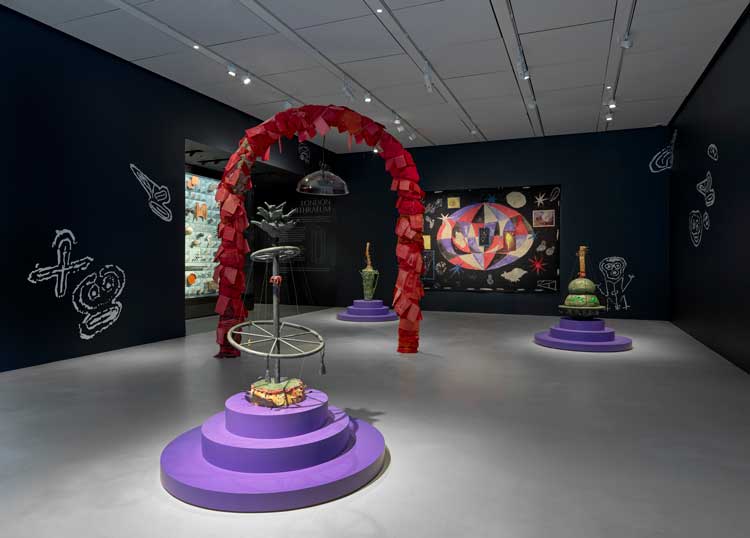
Leo Robinson: DREAM–BRIDGE–OMNIGLYPH, installation view, 2023, Photo: Marcus
Leith.
First built around AD 240-250, the mithraeum (a modern term) was rebuilt in the fourth century, its columns removed and the Mithraic sculptures buried under the floor. The temple was used until the late fourth century and then abandoned. Restored, relocated and opened to the public in 2017, decades after an inept reconstruction in the 1960s following the ruin’s discovery in 1954, the current installation was designed with judicious restraint from the company responsible for the curation of the 9/11 Memorial Museum in New York. Apart from the temple itself, hundreds of objects unearthed during excavations are also on view in a vitrine at ground level, though these represent a mere fraction of several thousand found artefacts.
The ground floor space also houses contemporary works in dialogue with the subterranean mithraeum, the serious design flaw being that visitors enter this room directly from the street, with no spatial buffer to separate the aura-killing mundaneness of ticket-checking and practical explanations from the “sacred” space of the exhibition. Currently on display is an installation by Leo Robinson (b1994, Newcastle-under-Lyme), whose interest in spiritual systems, symbolic languages and the unconscious is ideally suited to this site. Robinson draws on anthropological and psychoanalytic approaches in creating a fictional ritual space, weaving together diverse cultural signifiers that take the form of sacramental images and objects, partly echoing Mithraic initiation rites, but also referencing his own identity, the theme of displacement and migration being an integral part of the Roman world.
Studio International spoke to Robinson via Zoom.
Angeria Rigamonti di Cutò: Before discussing your current exhibition, can you tell me about your formal training at Manchester School of Art. Did you develop a sense there of the direction you wanted to pursue or did your real formation take place elsewhere?
Leo Robinson: Being at art school provided the space and freedom to let the things that were brewing inside me bubble up to the surface. Perhaps not necessarily the institution itself, but having that intensive period. I specialised in painting but was also making videos and sculpture - I’ve always bounced between mediums; I’ve never been that interested in becoming “skilled” in a specific medium.
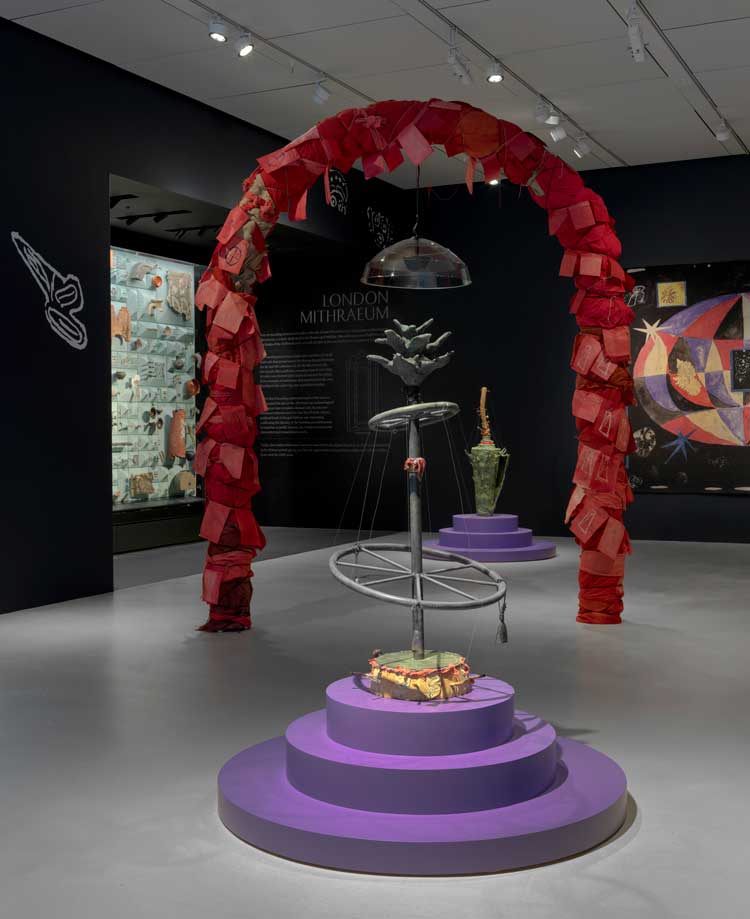
Leo Robinson: DREAM–BRIDGE–OMNIGLYPH, installation view, 2023, Photo: Marcus
Leith.
ARC: You also did a residency at Yinka Shonibare’s Guest Artists Space Foundation in Nigeria. What did that add to the research you’d been doing until then; did it bring in new elements?
LR: It came at the right time for me. I was delving a lot more into the African side of my ancestry, via the Caribbean. This was always within the practice, the idea of reconstructing lost systems of knowledge and rituals, but it’s got more distilled in the last couple of years, thinking about it in a specifically global context of the Atlantic triangle, displacement, belief systems, ways of being and knowing that got lost along the way. The chance to go to Nigeria at that specific time was important in consolidating some of those ideas, having conversations with lots of different people who had various relationships to Nigeria and Africa.
ARC: When you were then invited to create an installation in the contemporary exhibition space at ground level above the Mithraic temple, how did you want to relate your work to Mithraism, a rival cult of the Roman empire before Christianity prevailed?
LR: I had in mind that it was the religion that was in tension with Christianity; these were two belief systems at odds with each other. I was also thinking about identity within the diaspora and how these things are colliding with migration. On the other hand, I’m very interested in Jungian dream theory, so I was thinking about the descent into the temple.
ARC: I sensed you might have Jung in mind with the “dream” and “bridge” references of the exhibition title. Jung claimed to have dreamed – although some suggest he believed it to be a real apparition – that he had turned into the leontocephaline [lion-headed] figure of Mithraism, one of the cult’s seven stages of initiation. I took the “bridge” to signify the link between conscious and unconscious states?
LR: There were those more specific references to Jung’s exploration of Mithraism, but also from a more felt, experiential level, thinking about dream analysis and analysing my own dreams. The descent into the temple is the experience when you visit the Mithraeum and the motif of the man fighting the bull feels like some kind of ego battle, a conflict where you descend into this unconscious realm. And yes, I did want a bridge, or some kind of portal, into that unconscious realm.
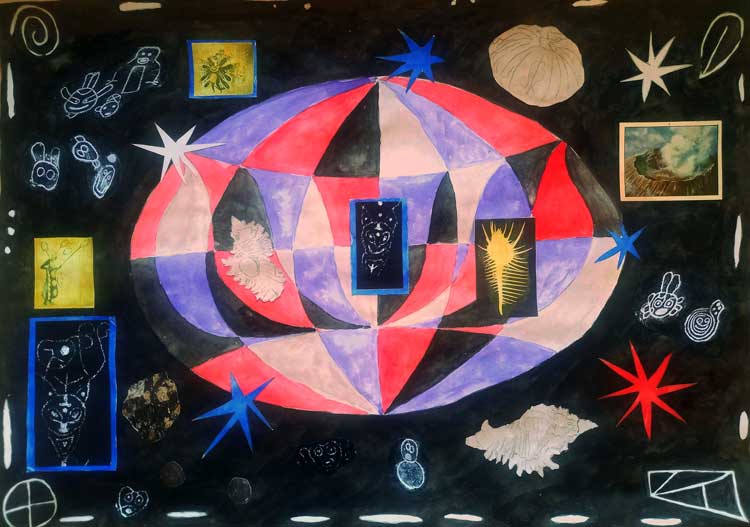
Leo Robinson, Omniglyph, 2023. Watercolour, collage, pencil, thermal print on paper. 42 x 59.4 cm. Courtesy the artist.
ARC: Your installation also shares the ground-level space with the display of artefacts unearthed around the mithraeum, so I imagine you were also responding to their presence?
LR: I liked the idea that my installation could absorb those into it, because I’m creating speculative artefacts, a speculative world that could potentially incorporate these real-life objects.
ARC: There was, of course, also a degree of speculation in the reinstallation of the mithraeum on this site, in the decisions made about the sounds, lights and overall design. The third element of your title is omniglyphs, presumably a variation or expansion of petroglyphs, which you’ve referenced on the gallery walls, specifically the pre-Columbian rock carvings of St Vincent and the Grenadines. Why did you want to incorporate these?
LR: Visualising my explorations of my ancestry as a kind of hero’s journey and thinking about what the guiding factors and obstacles are along that journey, I thought about these deities – which again, no one really knows anything about – so a lot of it is about filling in gaps with the imaginary in a similar way to how they installed the Mithraeum. Within my story, I take what concrete things there are and look at how they might all enter the same world or the same journey. So, there are these semi-figurative carvings on a rock on this island that I have a very distant relationship to, and that distance allows for a lot of speculation and reimagining. I think those figures take the role of spirits guiding us along the journey.
ARC: You’ve also used various other, possibly time-travelling, symbols – shells, flowers and what seem like sci-fi motifs.
LR: I have a constantly developing symbolic language and I’m always adding symbols, or reframe them from project to project, often in reference to existing belief systems. For example, with the shell, I’m thinking about the intention within Buddhism to transcend the duality between self and non-self. The shell sculpture is a musical instrument and the ritual that’s enacted with it would potentially create an environment where that duality would be transcended. Other references derive from existing belief systems but are encompassed within my own speculative systems.
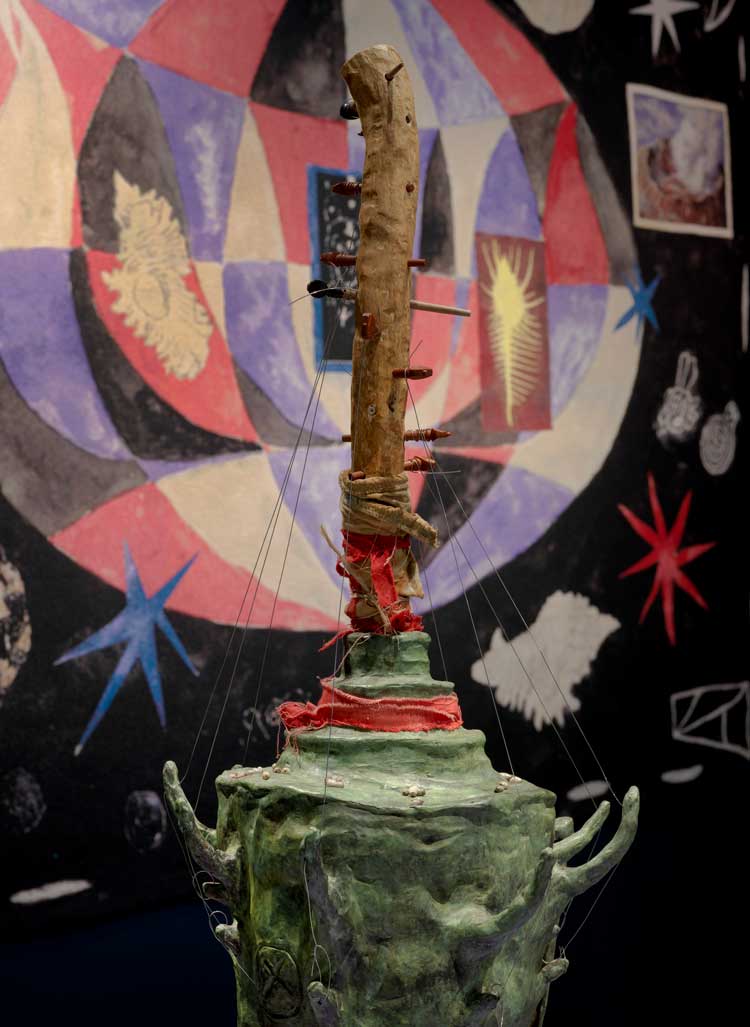
Leo Robinson: DREAM–BRIDGE–OMNIGLYPH, installation view, 2023, Photo: Marcus
Leith.
ARC: You have here, and in previous work, a clear interest in religious and ritualistic systems from different cultures. Has religion played a role in your own life, beyond an intellectual or artistic interest in its symbols and universal values?
LR: I would say yes, even though I wouldn’t necessarily say I am of a particular religion, I wasn’t raised religious. The way it appears in my practice reflects my personal explorations; I have engaged in a lot of Buddhist practices, meditations and so on, and that was my entry point into thinking about religion. When I started to think about myself, where I come from, my ancestral origins, there was a whole other level. I’ve also used the I Ching quite a lot, which informs my interest in divination and ritual practices, so there are a lot of influences coming in, first to me on a personal level and then the work reflects that. I wouldn’t say it’s predominantly an intellectual pursuit.
ARC: Looking at the forms of the works in this exhibition, you also combine very diverse media: sculpture, watercolour, fabric, carved wood, bronze, tapestry, sometimes forming these fantastical musical instruments. Did you expand your field of media for this exhibition?
LR: I think it’s very much expanded in terms of the material processes I was using. It was my first time using metal casting, I wasn’t personally casting but creating the forms to be cast, working with the foundry. With the tapestry, it was made using a kind of digital loom in Belgium. I sent them a scan of a drawing-collage-painting, which they converted into a sample for a tapestry.
ARC: There’s also an important acoustic element. I assume you also designed the soundscape emanating from the Portal, which seems to have layers of electronic music, chants, drumming and some indeterminate instruments. Is sound simply another means to evoke your fictional civilisation, to pitch it exactly as you want?
LR: It is. For me, sound is becoming more and more and important. In the past I created a lot of flat works speculating rituals, music and sound and eventually I started to think, how do I actually create this imagined music? This audio was a combination of the instruments being played by me and some field recordings from Nigeria. I went to Osun-Osogbo, a sacred grove a few hours outside Lagos, where there was a ceremony for Obatala, a creator deity, and made some recordings, not with the intention of using them, but they found their way in and act as a nice bridge between the entities and Nigerian practices.
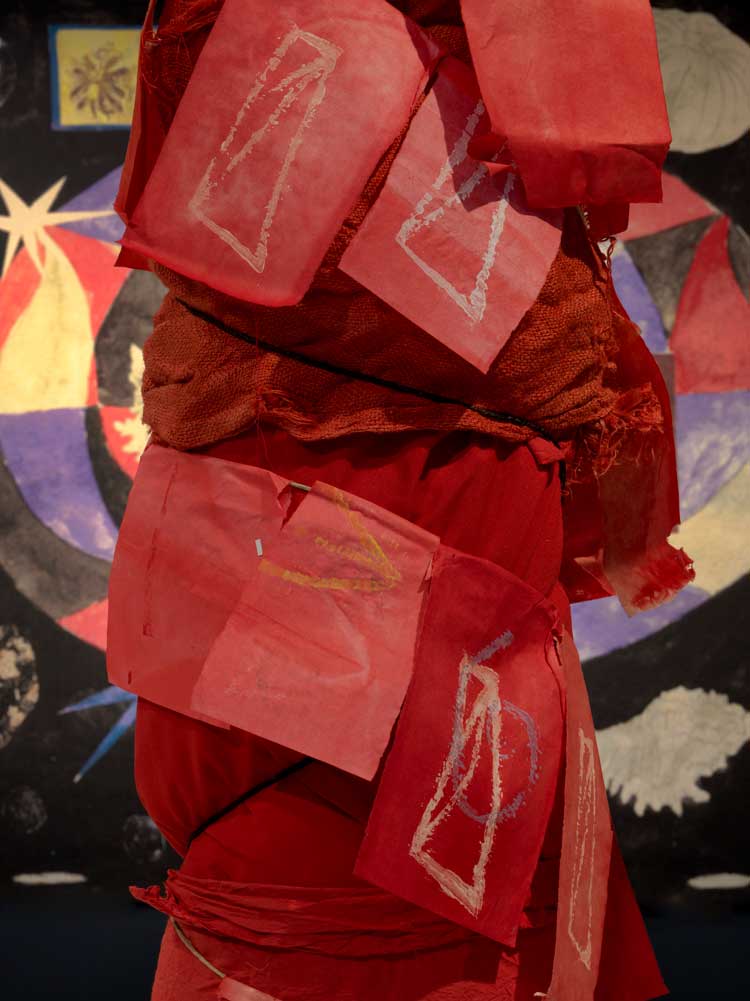
Leo Robinson: DREAM–BRIDGE–OMNIGLYPH, installation view, 2023, Photo: Marcus
Leith.
ARC: Throughout your work, it seems as if you’re using art as a tool to aid an exploratory or transcendent personal experience, which is how art would have been largely used before the enlightenment and the concept of art for art’s sake. Do you think that we need those experiences as much as ever, and that the contemporary cults of consumerism, digital technology, and now AI, have made that need more pressing than ever?
LR: I think human beings need meaningful symbols and narratives in order to understand themselves and their shared connections. There’s a real lack of that in the secular society, and even within a lot of religions that’s been pushed away. I’m coming at it from a more specifically diasporic angle, though I think this need exists throughout the whole world. I don’t think human beings will ever stop creating symbols in that way, without any deliberation on what’s being created.
ARC: The fact that the various layers of this exhibition, the Roman mithraeum and your spiritually inclined installation, all lie within that temple of finance par excellence, Bloomberg HQ, is interesting and in some ways discomforting. It seems impossible for either the artist or the spectator not to think about this singular collocation and the meanings it might engender.
LR: I spoke to a couple of people about it who used the word “curse”, which I thought was a really interesting framework from which to look at it. Uncovering an ancient temple, and building this financial monolith on top of it, has all the ingredients of some kind of historical curse. For me to create an installation between these two things, also awakening ancestral memories, means adding my own [curse], or uncovering an old one.
• Leo Robinson: Dream-Bridge-Omniglyph is at London Mithraeum Bloomberg Space until 29 June 2024.
Click on the pictures below to enlarge